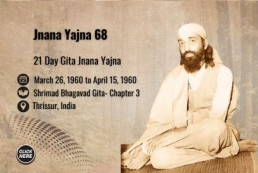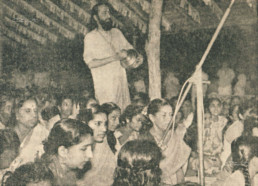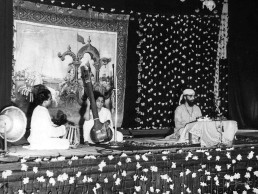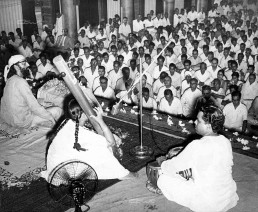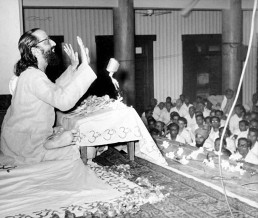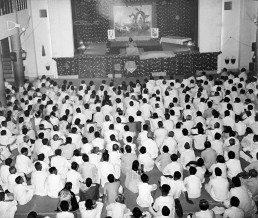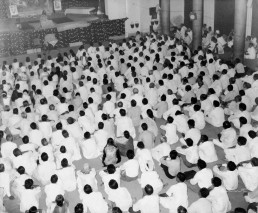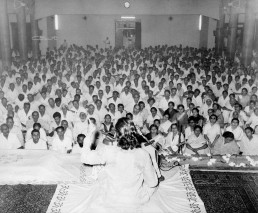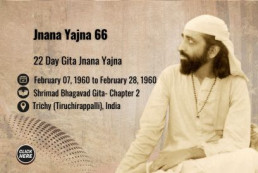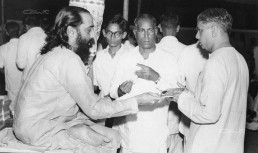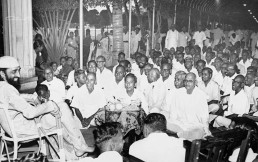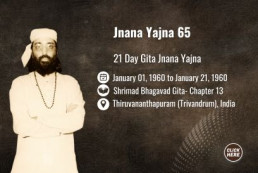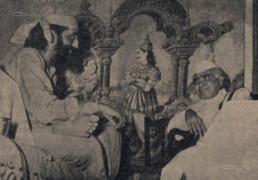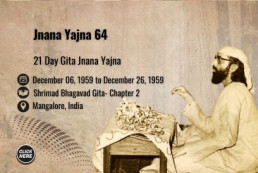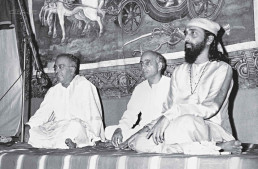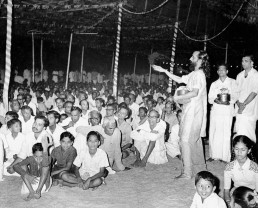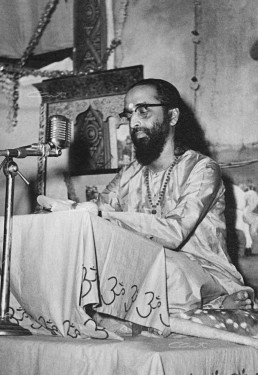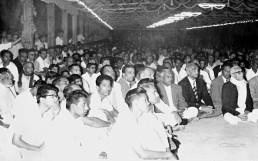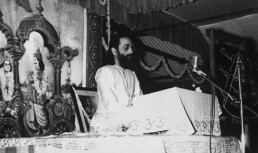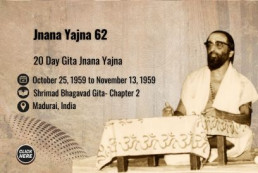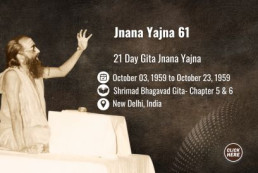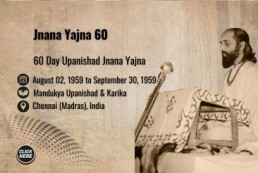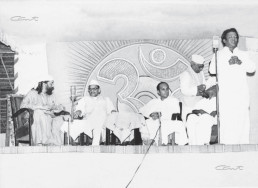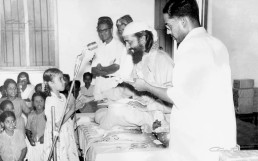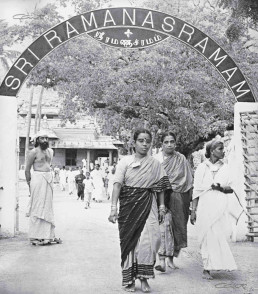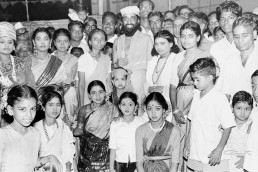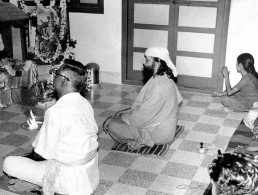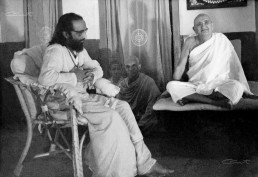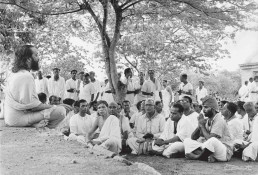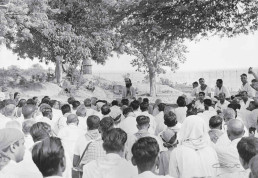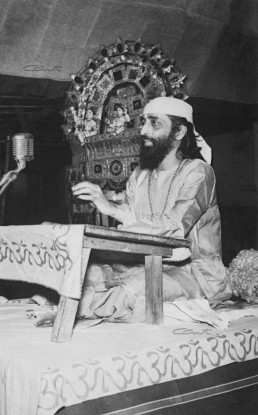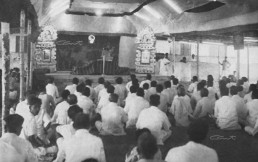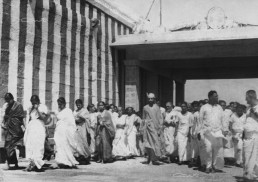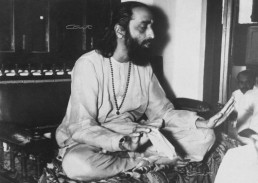Jnana Yajna 68
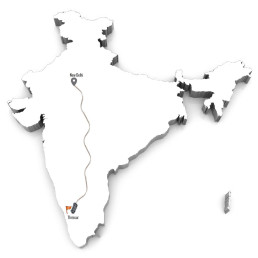
Jnana Yajna 68

Year & Dates:
March 26, 1960 to April 15, 1960

Yajna Topic:
Shrimad Bhagavad Gita- Chapter 3

Place:
Thrissur, India.
With the auspicious Grace of Bhagavan Shiva in the venerated Vadakkunnathan Temple, the 68th Jnana Yajna of Pujya Gurudev was inaugurated on March 26, 1960 by Dr. K. C. K. E. Raja, Vice-Chancellor of Kerala University. The yajnashala in front of the temple was predictably larger than the one constructed for the 1957 yajna. The reception of Pujya Gurudev with the energizing rhythm and resonance of the Panchavaadya and Naadasvara energized the atmosphere. After the Om Flag was hoisted by Sri K. Thangappa Menon, Secretary of the Yajna Committee, with the Raja and Rani of Kollengode attending, Sri Menon welcomed all. Stating how Vedanta was neither escapism nor pessimism, He reiterated the clarion call of Pujya Gurudev quoting Him: “Working in a spirit of dedication, chastened with right knowledge, is the culmination of devotion for the Lord.”
Mastering the Art of Action
The topic to be reflected on – Srimad Bhagavad Gita Chapter 3, Karma Yoga – holds Bhagavan Krishna’s principal guidelines for a meaningful life. Outlining how economic and scientific progress need cultural and religious reinforcement, Pujya Gurudev made the audience think about value-based actions that ultimately bring peace and prosperity to a country. He prefaced, “By developing Industry, and by constructing dams, by raising the Wealth of the nation, the History of that Nation cannot be built up; Science alone cannot inaugurate History. Similarly, religion alone cannot bring about History. But Science together with Religion alone can construct the History of a people. Rehabilitation of man nowadays is absolutely necessary. Even though we have got food, shelter, wealth and every comfort, yet we are miserable, unhappy. Still, we are in the quest of the unknown, the unrealised Peace.”
Pujya Gurudev devoted the morning sessions to a study of Kenopanishad. The deep study in that yajnashala had to be tested for its endurance. So, Nature unleashed a thunderous storm that struck down the pandal one evening at 3 pm. Again, there was no injury. Neither Pujya Gurudev nor the devotees were fazed. The pandal was re-erected within that night, a testimony to undaunted Karma Yoga. The forces of Nature withdrew to witness the 68th yajna march on with determination.
The Akhanda Kirtan on April 8th to 10th in the Krishna Temple at Kulacheri, the Vishnu Sahasranama Laksharchana on April 10th, and the Gangajal procession exemplified devoted actions. When Pujya Gurudev concluded His discourses on April 14, it was the New Year Day in Kerala – the Vishu. The Gurudakshina ceremony and Ganga jala prokshana marked a holy beginning with gratitude for the Guru’s blessings. A fitting conclusion was the yatra on April 15th to Kaladi, the birthplace of Jagad Guru Adi Shankara. In a memorable satsang there, Pujya Gurudev explained the difference between destiny and Purushartha: “What we meet in life is destiny, but how we meet them is our Purushartha. And what we meet in life is very insignificant, but how we meet them is very important, for the latter decides our future. Today we are no doubt the helpless product of our past (destiny), but surely we are the masters, the architects of tomorrow. For the past modified in the present is our future.”

“Think,” Says Pujya Gurudev
Through selfless work an individual gains an increasing amount of inner poise and when such a single-pointed mind is brought to function at the meditation seat, the mediator gains the experience of transcending his limited ego. To such a perfected one work is not a training to purify himself but it is a fulfillment of his own God-realization.
It is a fact that we are egged on to activity seeking and demanding a better satisfaction and a complete contentment. Satisfaction and contentment are two wheels of the life-chariot. In order to gain a better satisfaction and to reach nearer the point of contentment we are goaded to act in the outer world to earn and to save, to hoard and to spend. But the man of perfection, who, in the transcendence of his limited identification with his matter envelopments gets himself ushered into the All-perfect Realm of the Spirit feels so satisfied with the State of Self-hood which he attains, that he comes to experience a complete sense of contentment in that the very Divine experience is eternal satisfaction for him.
From Tyagi Magazine
Choose Freedom and Break Free!
The ego, driven by vasanas (impressions), mistakenly identifies itself as the doer, leading to suffering and confusion. The wise recognize the pure Consciousness behind all actions, understanding that the ego is merely a reflection, unaffected by the turmoil of the body and mind. By disengaging from egoic identification, one finds peace and clarity in the light of Consciousness.
Jnana Yajna 67

Jnana Yajna 67

Year & Dates:
March 02, 1960 to March 20, 1960

Yajna Topic:
Shrimad Bhagavad Gita- Chapter 15

Place:
New Delhi, India.
With an enthusiastic burst of pride, New Delhi had erected an extra-large Shamiana in front of the Gurudwara on Irwin Road, New Delhi and awaited the arrival of its favorite voice of Vedanta. Yet, when the crowd grew, that much-admired shamiana had to be extended twice to accommodate the record number of attendees. On March 2, 1960, Sri M. Ct. Pethachi Chettiar, Pujya Gurudev’s ardent disciple and president of Chinmaya Mission, Madras inaugurated the 67th Jnana Yajna. Sri. M. Ananthasayanam Ayyangar, Speaker of the Lok Sabha, extended a warm welcome to Pujya Gurudev and Delhi’s diverse audience. He recalled the Jnana Yajnas that he had attended and commended the way Pujya Gurudev was raising the cultural and spiritual awareness of the country with His Jnana Yajnas on the main Upanishads and Srimad Bhagavad Gita. The receptive audience in the capital city revelled in Pujya Gurudev’s discourses on the exalted Purushottama Yoga of Bhagavad Gita’s 15th chapter.
A Vision Above Interruptions
As Pujya Gurudev glorified the Infinite Truth on the big stage, the clouds began pouring. The dry and cold winter gave way to heavy downpours and active thunderstorms which wrecked the yajnashala. Almost as if the wind god too wanted to test the resolve of the Delhi audience, an intense dust storm with gusts up to 90 mph, also ripped the whole city and the yajna shamiana. Resiliently, the yajna persisted through the interruptions that Nature caused and even gained another stage!
On March 12th, on the request of a patron, Sri Gobind Lal Dhingra, Pujya Gurudev began an 8-day discourse in the mornings in Hazrat Nizamuddin, a new locality, on Gita chapter 12 which Sri B.N. Dattar, the deputy minister for Home Affairs inaugurated. Another impediment arose in the form of Pujya Gurudev’s dental procedure; an extraction of four of His upper molars caused heavy bleeding and prevented the evening discourse on March 19th. Braving through the pain, Pujya Gurudev did conclude Ch.12 in the morning classes. However, He developed a very high fever, and the evening dedicated to a Q & A session had to be cancelled. Pujya Gurudev had anyhow ensured that He had completed His exposition on Gita chapter 15 even by March 18th. He arranged for a devoted sevika, Mrs. Sheila Puri, to complete the Guru Dakshina ceremony and distribute the Yajna Prasad booklets to a caring audience who participated with discipline and adoration for their indisposed Guru.
Giving His swollen cheeks and fever-ridden body hardly any rest, Pujya Gurudev left Delhi for Mumbai on March 22, 1960, to supervise the preparations for Sandeepany Sadhanalaya, the Vedanta College that He was working tirelessly on amid the Jnana Yajnas. He oversaw the important step of depositing all the collected funds in the Indian Overseas Bank; thenceforth, all contributors could get their official donation receipts from Tara Cultural Trust (TCT) Office, Sakhi Vihar Road, Powai, Bombay. The land for the visionary college had already been donated by Smt.Tara Sarup, and TCT had been registered on January 19, 1960.
Pujya Gurudev functioned far above the challenges of circumstances or His own body, empowered by the Infinite.
Photo Gallery

“Think,” Says Pujya Gurudev
The manifested world constituting the Ashvattha-tree can be cleft ‘by the strong axe of detachment’: The world of matter is inert and insentient. The experience of life gained through it is known and lived only because of the play of Consciousness upon it. So long as the wheels of a car are geared on to the machine the vehicle moves. In case we can clutch off the motive power from the moving wheels, the vehicle must necessarily come to its own natural condition of motionless stillness. Similarly, if the Consciousness is withdrawn from the body-mind-intellect vehicle, its play of perception-emotion-thought must necessarily halt. This clutching off of Consciousness from the inert matter vehicles is detachment. With the axe of detachment Krishna advises Arjuna to cut down the Tree of multiple experiences.
From Tyagi Magazine
Only a fool says this!
Despite being constantly present in every aspect of existence, those blinded by ignorance fail to recognize the divine presence. Denial of God equates to denial of self, as one’s very existence is inseparable from the divine. Those with discerning intelligence perceive and experience the glory of God.
Jnana Yajna 66

Jnana Yajna 66

Year & Dates:
February 07, 1960 to February 28, 1960

Yajna Topic:
Shrimad Bhagavad Gita- Chapter 2

Place:
Trichy (Tiruchirappalli), India
It was a spiritual windfall for the overjoyed seekers in Tiruchirappalli when Pujya Gurudev wrote indicating that He was available if a Gita Jnana Yajna could be arranged at short notice. This sudden fortune that came from the Guru Himself was because of the rare occurrence when a yajna planned elsewhere got canceled.The yajna committee in Trichy jumped into the preparations heart-first, and a huge Pandal stood ready in Thillai Nagar, the very place where Pujya Gurudev had spoken in His earlier Yajna in July 1959. The time was short to find a dignitary to inaugurate the 66th Jnana Yajna, Trichy. Again, the best outcome happened because Pujya Gurudev Himself inaugurated the yajna on Feb. 7, 1960, bringing greater happiness to the audience who welcomed His uninterrupted flow of thought from the opening minutes. The yajnashala was brimming as Pujya Gurudev transformed it into a Dharmakshetra.
Led by Shri Krishna and Adi Shankara
Tiruchirappalli basks in rich history, lyrical Tamil poetry, great philosophy, and a sacred aura because of its eminent temples. It was in the famous Sri Ranganatha Temple that the renowned poet Kamban first recited the celebrated Kamba Ramayanam, the immortal epic of Ramayana in Tamil.
Knowing Tiruchirappalli’s deep cultural heritage and having shared the knowledge of both Bhakti Yoga – chapter 12 and Purushottama Yoga – Chapter 15 in previous yajnas, Pujya Gurudev deemed that the audience was ready for the comprehensive essence of Gita’s chapter 2, the summative Sankhya Yoga. The beauty of chapter 2 of Srimad Bhagavad Gita is in how Bhagavan Krishna shakes Arjuna out of his stupor with the most profound essence of all Vedanta. Thus, chapter 2 encapsulates the entire breadth of teachings which are then expanded in the following sixteen chapters of the ever-relevant Gita. Pujya Gurudev, while strongly reminding the audience that Gita was universal and not parochial, brought out the importance of facing the world’s challenges with courage and conviction. He clarified that the Gita is not for escapists who claim that life is unreal like a svapna, a dream. Rather, dealing with life’s struggles as though life is svapnavat (dream-like), empowers one to live like a sthitaprajna (established in Truth).
The introspective collection of verses of Atma Bodha, an important preparatory text written by Shri Adi Shankara, was the focus in Pujya Gurudev’s morning discourses. As He introduced the fundamentals of the Advaita philosophy, Pujya Gurudev highlighted how the young Sri Sankara sparked a great revival of Sanatana Dharma at a time when the universal spiritual values were overshadowed by rampant ritualism and materialism. The Vedantic texts like Sri Shankara’s Atma Bodha awakened seekers to then grasp the unifying core of the upanishads for leading an integrated life.
It was a sublime 66th yajna where the audience were engrossed in Pujya Gurudev’s powerful exposition of both the sacred scriptural texts. Sweetening their intense contemplation with the sweet devotion to Bhagavan Krishna, the Laksharchana ceremony on February 21, 1960, was a devotional feast for the eyes and the heart. With gratitude, the Trichy audience recalled how it was in the 43rd Jnana Yajna at Trichy’s Golden Rock area that Pujya Gurudev had first incorporated the feature of such Laksharchana in His Jnana Yajnas.
Photo Gallery

“Think,” Says Pujya Gurudev
Thus, the Eternal Spirit in man asserting its false relationship with his body comes to feel bound by a thousand relationships with the world of things and beings among the outer objects. The same perfect Principle-in-life playing on the field of the mind comes to experience the imperfections of the emotional world as its own. The Divine-Spark-of-Life again, as it often does, assuming a false identity with the intellect, comes to sob and suffer for its hopes and desires, its ambitions and ideologies, which are the characteristic pre-occupations of the intellect.
The self thus getting reflected in the intellect, body and senses is the ego which is the victim of the world of objects, feelings and ideas. To this ego belongs all the sad destinies of life and the fleeting thrills of acquisition and possession. The ego it is, in Arjuna, that came to suffer its neurotic condition, goaded by its own delusions and its instinctive mis-apprehensions. Krishna knew in his Infinite Wisdom that mis-apprehension of Reality can take place only when it is preceded by a pitiable non-apprehension of Reality. Therefore, in order to cure the very source of Arjuna’s delusion, Krishna is here advising him the very cream of knowledge as declared in The immortal books of the Hindus, the Upanishads.
From Tyagi Magazine
Is Equanimity Possible?
Here is an excerpt from the teachings on Bhagavad Gita that uncovers the secrets of maintaining mental equanimity in the face of life’s challenges and desires. How does a man of wisdom attain the state of deep tranquility and learn practical techniques to cultivate inner peace in our own life.
Jnana Yajna 65

Jnana Yajna 65

Year & Dates:
January 01, 1960 to January 21, 1960

Yajna Topic:
Shrimad Bhagavad Gita- Chapter 13

Place:
Thiruvananthapuram (Trivandrum), India
“We are thankful to the Lord for the spirit of cooperation that we have been witnessing in all the yajnashalas and also for the new awakening felt all over India as a result of our constant and dedicated efforts. To the Lord, who is the true Yajna Adhyaksha everywhere, we offer all our achievements so far made, and prostrate to draw new inspiration from Him for facing the new years that lie ahead, and to strive the more, always in the service of our culture.” Thus penned Pujya Gurudev in an early 1960 editorial of Usha.
His 65th Yajna inaugurated on the evening of January 1, 1960 was a truly inspirational blessing for Thiruvananthapuram, Kerala. The celebratory spirit was obvious in that bright, aesthetically pleasing, grand pandal measuring 150′ by 100’ praised as “the grandest and the biggest ever erected in the city of Trivandrum.”
Growing through the Gita
In his inaugural address, His Excellency the Governor of Kerala, Sri Ramakrishna Rao, encouraged the audience to integrate the Gita way of life in line with Pujya Gurudev’s teachings. He brought attention to how Srimad Bhagavad Gita was “the never-failing book of inspiration” for Mahatma Gandhi, the Father of the Nation. In difficult situations and moral dilemmas, Gandhiji would reach for the Gita which always guided him with the right resolution to implement.
Pujya Gurudev’s discourses in the evenings were on Gita, chapter 13, and His morning classes were on Kenopanishad. In His introduction, Pujya Gurudev explained how Chapter 13 identified the relationship between the Knowing Principle (Kshetrajna) and the field of experiences (Kshetra). In the modern world when the focus of happiness is more on the environmental level rather than on self-improvement, the experience of joy is hollow. So, unless an individual is fully equipped with a pure mind and clear intellect, happiness will not be realized no matter what changes in economy, politics, or scientific advancements.
To purify the mind through devotion, the Vishnu Sahasranama Laksharchana was performed on January 10th. Thiruvananthapuram being the place of the sacred Sri Anantha Padmanabhaswamy temple, that daylong worship melted the hearts of all devotees who had been learning from Pujya Gurudev how the substratum of all experience is that all-pervasive Divine Presence. Another notable event during the 65th Jnana yajna was the reverential observance of Tapovan Day on January 13th. That day, the class and discourse were canceled as Pujya Gurudev withdrew in remembrance of His great Guru, spending the day in silence, fasting, and meditation.
January 16th and 17th went by in a memorable yatra to Madurai, and a vibrant Kathakali performance embellished the yajna’s conclusion on January 21st.
After the 65th Jnana Yajna, Pujya Gurudev graced the first “All India Chinmayee Devi Sammelan” held in Kollengode during January 23-25, 1960 to encourage “the motherly hands” of Devi Groups “in molding the brilliant future of our Land.”
Chinmaya Mission, with its enriching Study Groups, blossoming Bala Vihars, and nourishing Devi Groups was gathering full steam as a spiritual renaissance when 1960 opened up.
Photo Gallery

“Think,” Says Pujya Gurudev
He alone sees who sees this:- This is a very powerful and direct assertion. Everybody sees; but not the Real. Wrong perceptions indicate maladjustments in the instruments of perception. Hallucinations and illusions, false imaginations and delusory projections of the mind veil the reality of a thing observed. Therefore, here the Yogeshwara asserts that he who recognizes this harmony of one Truth, this thread of Reality, that holds all experiences together, which is one in all beings, is the Truth to be realized in the world. Others see, and yet, do not see; he alone sees who realizes this Supreme Lord that is the Imperishable.
From Tyagi Magazine
100% Transformation Guaranteed!
In the video excerpt, Pujya Gurudev expounds on the essence of undivided devotion and its transformative power in our lives. Through practical insights and guidance, discover how to navigate distractions and overcome worldly attachments, paving the way for a deeper spiritual practice.
Jnana Yajna 64

Jnana Yajna 64

Year & Dates:
December 06, 1959 to December 26, 1959

Yajna Topic:
Shrimad Bhagavad Gita- Chapter 2

Place:
Mangalore, India.
Mangaluru had savored, for the first time in 1958, the transformational taste of Vedanta through Pujya Gurudev’s Jnana Yajna. So, when the news spread that He was coming to enlighten all on the treasured wisdom of Srimad Bhagavad Gita – Chapter 2, auspicious cheer filled Mangaluru. The Government College Authority hastened to offer the biggest of its playgrounds as the yajnashala for Pujya Gurudev’s 64th Jnana Yajna.
The inauguration at 6 pm on Dec.6, 1959 was marked with delight and discipline for dedicated learning. The Chinmaya Bala Vihar children who offered flower petals and chanted the Gita delighted Pujya Gurudev. The discipline which the audience displayed indicated their eagerness. And, Dr. T. M. P. Mahadevan, the head of the Department of Philosophy in Madras University and a great exponent of Bhagavan Ramana Maharshi’s teachings, inaugurated the Gita Jnana Yajna.
Blessed by Bhagavan Krishna
At Mangalore, in the morning sessions that started at 7:30 am, Pujya Gurudev first completed the final verses of Atma Bodha left unexplained from the previous yajna. By that very act, Pujya Gurudev indicated how He cared for the seekers’ thorough understanding. Only after that, did He launch into the glorious Mundakopanishad as the audience doubled in number.
The sparks from the second chapter of Gita were brilliant. To learn how to serve and then come to deserve, to look at death as simply a change from a worn-out attire, to elevate duty with knowledge and surrender, to adopt the qualities of a Sthitaprajna witnessing life like one of those two symbolic birds of Mundakopanishad -the Upanishad in the morning and the Gita in the evening just flowed into each other and flowed through the aspirants.
Hearing how enriching Pujya Gurudev’s Gita Jnana Yajna was, His Holiness Swami Raghumanya Thirtha, pontiff of Palimar Mutt (1947-2000), met Pujya Gurudev who offered the Madhwa sannyasi a separate stage and invited him to address the audience in Kannada on the final day of the yajna.
Pujya Gurudev then visited the temple for Sri Krishna installed over 850 years ago in Udupi by Sri Madhwacharya, the Master of Dvaita philosophy. That evening, a young black cow walked regally into the yajnashala during Pujya Gurudev’s description of the “Divine Song of Gopalanandana” and unhurriedly moved through the thousands close to the dais where Pujya Gurudev was and then exited quietly. Later when a devotee wondered aloud, “Was it Gopalakrishna who had paid a return visit to Pujya Gurudev?” Pujya Gurudev just smiled.
The eye-and heart catching Laksharchana, the Gangajal Prokshana with the holy Ganges water brought down from Rishikesh, and the reverential Guru Dakshina ceremony with the prasad booklet entitled “As I think” made the yajnashala a powerhouse of spirituality. The crowning touch to the Jnana Yajna was the yatra to the sacred temple of Lord Subrahmanya. The 300 devotees were immersed in the bliss of satsang with Pujya Gurudev and the Avabhruta Snana in the nearby river ‘Kumaradhari.’ When Pujya Gurudev directed the group to meditate in solitude in a scenic river bed at the confluence of the Netravati and the Kumaradhari rivers, the serene silence that engulfed all was the lasting takeaway from a noteworthy yajna.
Photo Gallery

“Think,” Says Pujya Gurudev
The three inseparable Gunas always remain in the inner constitution of every living creature in varying proportions. The mind and intellect are constituted of this stuff. To go beyond these three temperaments is to literally go beyond the mind. If there is an alloy constituted of copper, Zinc and tin, and a pot is made of that alloy, then to remove all tin, zinc and copper from the pot is to destroy the pot completely. Tea is made of hot water, tea leaves, sugar and milk; and form a cup of tea if you are asked to remove these four aspects of it, it amounts to saying ‘empty the cup’, In the direct language of the Upanishads, man has been advised to transcend the mind and intellect, and they promise that the individual shall thereby re-discover himself to be God. This direct explanation came to frighten the Hindu folk out of the Arvan-fold and here the Call of the Renaissance also means the same but puts it in different words when it says: “Arjuna, transcend the Gunas.”
From Tyagi Magazine
Where is your Mind?
Delve into the Bhagavad Gita’s teachings on mindful living and learn how to integrate its principles into your everyday activities. Explore the concept of yoga as dexterity in action and uncover practical strategies for staying present and focused in all your endeavors.
Jnana Yajna 63

Jnana Yajna 63

Year & Dates:
November 21, 1959 to December 05, 1959

Yajna Topic:
Shrimad Bhagavad Gita- Chapters 12

Place:
Mysore, India.
“It is the parents who look to the development of the child; it is the teacher who develops the intellect, and it is only the Acharya Purusha who will enlighten him, to the philosophic content of man,” said Shri B. D. Jatti, Chief Minister of Mysuru as he inaugurated the 63rd, 15-day yajna on the evening of November 21, 1959. He pointed out that faith is crucial for both personal and spiritual evolution, and Gita showed the way. He further stressed that “by following that method taught to us by the Gita, and by that method alone, the ego in us would burn down as the fuel and the ghee in the Agni-kunda.” The state government provided the Mysuru Dasara Exhibition Buildings as the yajnashala venue while also hosting Pujya Gurudev in the government guesthouse.
Devotion That blessed the Devi Group
The endearing way of using anecdotes, parables, and daily interactions to convey the nuances of the Gita way of life attracted people in Pujya Gurudev’s every Jnana Yajna. The eager audience converged at the yajnashala every morning and evening, filling it and all neighboring vantage spots so that they did not miss a word that Pujya Gurudev uttered! Just the voice and presence of Pujya Gurudev removed all restlessness; silence was a natural state for that huge crowd. With the addition of a mass recitation of the Gita, Pujya Gurudev’s teachings resonated more. The devotional outpouring during the Laksharchana of Bhagavan Vishnu with flowers and His Sahasranama on December 29, 1959, made every devotee recall the attributes of perfect devotion which had been illumined in the Chapter 12, Bhakti Yoga. Throughout that Jnana Yajna, Pujya Gurudev demonstrated that Gita was not just a part of an epic, but a mode of life, universally applicable so that “a Hindu would become a better Hindu, a Christian a better Christian; and a Muslim, a better Muslim.”
There was a sweet prelude that took place before the Mysuru Yajna which traces the strengthening of the Chinmaya Devi Groups across India. Almost a year after Pujya Gurudev blessed the initiative to have an exclusive forum for women seekers, the Chinmaya Devi Group first founded in 1958 at Chennai prayed for Pujya Gurudev’s Presence on their first anniversary celebration on November 16, 1959. Pujya Gurudev’s calendar was fully booked, and there seemed to be no opening. However, a small unforeseen delay between the Madurai and the Mysuru Jnana Yajnas became the happiest fortune for the Chinmaya Devi Group. Pujya Gurudev came on November 16, 1959, to Chennai. A most colorful welcome with a melodious Subrahmanya bhajan and the Gurustotram, a carpet of flowers of twelve colors to represent the twelve months that lined His path, and an unusual peacock throne with a beautiful five-year-old dressed as Lord Muruga inviting Him to sit beside her – Pujya Gurudev was astonished as He applauded the enthusiasm of the Devis and encouraged them to greater spiritual accomplishment.
Photo Gallery

“Think,” Says Pujya Gurudev
“If you are unable to fix your thoughts steadily on Me ”, then the only practical method would be to pursue the ‘Yoga of constant practice’ (Abhyaasa Yoga). This Yoga of Practice was earlier described as: “Wherever the mind wanders, restless, from thence let him subdue it and bring it under the sway of the Self alone”. In short, whenever a meditator tries to meditate by fixing his mind upon the chosen point-of-concentration the fickle mind will always try to run wild into dissimilar thought-channels. The advice here is to gather all the rays of the mind, whenever they wander away from their main point-of-concentration, and focus them all again and again at the Divine Form.
From Tyagi Magazine
Krishna, the Lord of Yoga, could not be more practical as when he advised this path to ordinary average man. It gives hope even to the most extrovert among us. It is a royal path indeed to the majority of us. Just as a firm’s representative while talking always associates himself with his firm and says “we shall try to supply we are producing we are not responsible” etc., here he identifies himself with the great manufactures as if he is one of the directors of the firm, although, in fact, he is only a low paid local agent. Similarly, if anyone of us were to really entertain in our mind the firm idea that we are the agents of the Divine executing His Will in all our external activities, then not only our mind is thereby made to contemplate on the Lord continuously, but we shall be drawing from ourselves miraculous power of efficiency, organizational dexterity and a self-assuring courage, in all our undertakings- big or small.
From Tyagi Magazine
How to deal with Grief?
Unveil the secret to inner peace and fulfillment through the Bhagavad Gita’s guidance on handling life’s challenges. Acquire practical tools to let go of worries and live with clarity and purpose. Delve into how to respond to life’s twists and turns with resilience, wisdom, and compassion.
Jnana Yajna 62
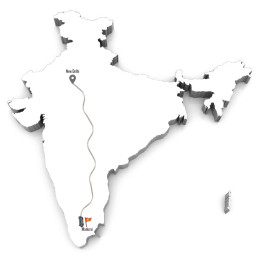
Jnana Yajna 62

Year & Dates:
October 25, 1959 to November 13, 1959

Yajna Topic:
Shrimad Bhagavad Gita- Chapters 2

Place:
Madurai, India.
As the flight landed in Madurai on October 25, 1959, the clouds saturated with joy on Pujya Gurudev’s arrival began to pour. It was as though they washed the path that led to the magnificent Meenakshi Sundareshwara temple.So, when Pujya Gurudev stepped out at the entrance of the shrine, the earth was clean and fragrant, and the sky had become quiet in expectation of the 62nd Jnana Yajna. After a traditional welcome and a wonderful darshan of Goddess Meenakshi and Lord Sundareshwara, the yajna began in the brightly-lit, festooned pandal outside the Natesha Ayyar Reading Room, Chinnachockikulam. At the inaugural ceremony, Sri. Alagusundaram Chettiar, president of the yajna committee, praised Pujya Gurudev with these words: “Your frequent journeys through every nook and corner of our Bharata Varsha are a vivid reminder to us of the legendary digvijayas (victorious march in all four directions)…our sages and saints are said to have performed in the course of their lives.”
Jnana Ganga- His Sacred Digvijaya
To establish another spiritual victory in the hearts of an adoring audience, Pujya Gurudev prefaced: “We can compare the Gita to a popular science magazine. The scientific truth remaining the same, its treatment is simpler in the magazine than in the great textbooks. Similarly, Vyasa had edited the Upanishads and given their essence as a popular treatment in the Gita.” The sheer eloquence of His exposition on the second chapter of the Gita in the evenings at the pandal captivated the minds of the seekers who listened unmindful of the evening showers. His morning classes of Kenopanishad in the Kalyana-mandapam within the Meenakshi temple also drew a large, dedicated crowd. Madurai was carried to dizzy heights of spirituality with the sthitaprajna lakshana of Gita chapter 2 and the brilliant analysis of Kenopanishad. The bliss of the yajna continued through the yatra to Tiruchendur on November 7th and 8th and culminated in the Avabhrta snaana at sea and a most thrilling darshan of Lord Muruga during the famous skanda Shashthee festival.
A singular, brilliant landmark was quietly achieved on the Dipavali Day of October 31, 1959 in Madurai. Pujya Gurudev had completed dictating His Gita discourses to present to the world, His greatest commentary on the Holy Gita. What was so amazing about that accomplishment, especially since the project took 4 years and 2 months – 1520 days ? May the numbers show the saga of Jnana Yajnas and His Likhita Ganga:
- Total Manuscript – 2085 foolscap (8 x13 inches) pages double-spaced
- Dictations began in 1955, published in segments in Tyagi from September 1955
- Pujya Gurudev traveled 5,000 miles by car, 10,000 miles by train, 20,000 miles by air in those four years.
- 62 Jnana Yajnas across India which gave rise to 500 branches of Chinmaya Mission, each having four to five Chinmaya Study Groups and the new wings of Bala Vihars and emerging Devi groups
- Organizational work and Beginning the journals – Tyagi & Usha
- Initiating work on Sandeepany Sadhanalaya in Powai, Mumbai, selecting that venue after plans in four different locations did not materialize
Undaunted and untiring, Pujya Gurudev had gifted us the 4,60,000 word commentary on Shrimad Bhagavad Gita, all the while roaring the scriptural message everywhere.

“Think,” Says Pujya Gurudev
In the tradition of religious devotion, it is very truly said and firmly believed all over the world, that the Lord, in His high seat, keeps mum and almost deaf so long as we are arguing and asserting our maturity as intellectual beings. But when we come down to live and act as an emotional being, when tears of desperation trickle down the cheeks of a true soul, even unasked, the Lord of Compassion rushes forward to reach the lost soul and guide him out of his inward darkness to the resplendent Light of Wisdom. A soul identifying with the intellect can seek and discover itself; but when it is identifying with the mind, it needs help and guidance.
When the Lord’s grace comes, as it comes here in the Geeta, it first reaches man with a stern vehemence, almost shattering in its impact. The fiery touch of the Lord’s grace when it descends upon his devotees, is invariably felt by the seeker more as an avalanche than as the refreshing shower of Divine Mercy. The Spiritual Grace must necessarily re-orientate the heart and burn away its negativities, before the spirit can radiate its sway upon matter.
From Tyagi Magazine
Anxiety over Future?
In this insightful discussion, Pujya Gurudev Swami Chinmayananda delves into the importance of centering on the present moment and investing our energies fully in our current pursuits. Explore methods to transcend apprehensions about the future and prevent the scattering of mental strength by remaining anchored in the present task. Uncover the profound impact of aligning actions with genuineness and integrity, liberated from fixation on outcomes or the temptation of idleness.
Jnana Yajna 61
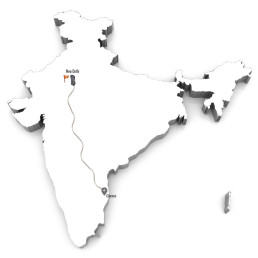
Jnana Yajna 61

Year & Dates:
October 03, 1959 to October 23, 1959

Yajna Topic:
Shrimad Bhagavad Gita- Chapters 5 & 6

Place:
New Delhi, India.
The turf was familiar, and when walking into the premises of the Modern High School, Barakhamba Road, in New Delhi, one could recall the very first Gita Jnana Yajna of Pujya Gurudev in 1955 on those same grounds. So, when the 61st Jnana Yajna commenced on October 3, 1959, the audience of New Delhi were nostalgic and ready to tune into the Celestial Song of Bhagavan Krishna through the powerful rendition of Pujya Gurudev Swami Chinmayananda who had showered His Grace on New Delhi in several previous yajnas.
The inaugural ceremony shone even more as Swami Ranganathananda, of the Ramakrishna Mission who emphasized practical, universal Vedanta, graced the opening day. In his welcome address, Shri Mohan Kapoor of the Delhi Yajna Committee expressed how Pujya Gurudev’s discourses were the much-needed prescriptions to cure the precarious imbalance of the times.
Ishwara Tattva in Guru
A crucial bridge between Karma Yoga and Pure Meditation is how Pujya Gurudev described Gita chapter 5. Titled the Renunciation of Action, it details what is the spirit of renunciation and what is meant by the Yoga of Renunciation of Action. Pujya Gurudev spelled out the effects of actions done with this attitude particularly on the inward development and spiritual evolution. He then guided the sincere audience to the portal of chapter 6, the technique of meditation, of taking the mind trained to renounce the sense of agency or the anxieties for the results of actions and direct it toward self-unfoldment.
As a practical exercise in spirituality, Pujya Gurudev announced that the Avabhrta snaana trip for the 61st yajna would be to Garhmukhteshwar, a sacred place on the banks of Ganga, 55 miles away from Delhi. He reminded seekers that it was a trip of 24-hour temporary sannyas with minimal focus on bodily comforts. On the evening of October 17, 1959, 126 devotees boarded three buses with joyful kirtans to reach the dharmashala at Brij Ghat which is near Garhmukteshwar. Under a full moon sky with the gentle lapping waters of the scenic Ganga in the background, the satsang with Pujya Gurudev full of His energy and humor was a sublime experience. The sacred bath in the Ganga early next morning was refreshing. After that, the devotees gathered around Pujya Gurudev for three to four hours in the central hall of the dharmashala to listen to his invaluable explanation of how Dharma should become one’s lakshana (characteristic) through uncompromising sadhana. He said firmly that aspirants should meditate not on the personality of a living Guru but must contemplate on the spiritual ideals that a Guru taught, the Ishwara Tattva behind the Guru, symbolized as the Real Guru Mukteshwar.
Interestingly, as time went unnoticed in that timeless satsang, the group could not visit the actual temple. However, Pujya Gurudev posed a thought-provoking question: “”If after the Ganga-bath and the Spiritual Life you lived, you still think that you have not visited Guru Mukteshwar, then whom can we blame?”it

“Think,” Says Pujya Gurudev
“Man should uplift himself by himself” is the open statement declared by no less a person than Lord Krishna Himself-not cooed in a playful mood in the company of the Gopikas of the Jamuna-banks at a hilarious hour of laughter and play, but roared to Arjuna of the battlefield at a serious moment of His life’s fulfillment as an Avataara. Man, if he wants to exalt himself into his greater cultural and spiritual possibilities, now lying dormant in him, he has to raise the lower in himself to the greater perfection that is the true and eternal central core in himself.
From Tyagi Magazine
Specially prepared milk powder diluted with hot water is the full diet for an infant. But the same feeding-bottle will not satisfy the growing demands of a boy vigorously working and mischievously knocking about all day around. To him more solid bread and butter is the diet. We need not be great intellectuals to understand that buttered toast at the same time would choke and kill an infant child.
Similarly, here, work without self is healthy for the beginner, but a developed seeker needs more and more quietude and self-withdrawal for growing in his steady contemplation of the life within. Earlier, ‘wok-with-out-self’ is the means, afterwards ‘work on Self’ is the means: and the process is continued until, working or not working, through meditation it is realized that the Self alone is the essence in the ego which till then was recognized as the only reality.
From Tyagi Magazine
A good person cannot be miserable!
Discover the unidirectional nature of spiritual evolution, where every conscious choice and righteous deed propels us forward on the path of self-discovery and enlightenment. Join us as we navigate the peaks and valleys of our journey, understanding that setbacks are not regressions but opportunities for growth and refinement.
Jnana Yajna 60
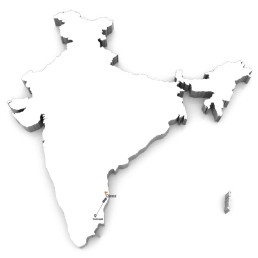
Jnana Yajna 60

Year & Dates:
August 02, 1959 to September 30, 1959

Yajna Topic:
Mandukya Upanishad & Karika

Place:
Chennai (Madras), India.
“The task that Swamiji has set before him is precisely to undertake this mission, to blow away the dust that has settled over our great scriptural works, take out and polish the old ideas contained in them, by giving a coat of fresh paint, as it were, and present such ideas to the people of our country in a manner which is easily assimilable. It is a noble, elevating, and commendable task, and Swami Chinmayananda is doing a great service to the country.” So spoke the president of the Madras yajna committee, Sri. M. Ct. Pethachi, as he welcomed Pujya Gurudev for the 60th Jnana Yajna on August 1, 1959. Sri Gulzarilal Nanda, a minister and economist, remarked that moral stature is required to avert an economic debacle in the land.
And, Pujya Gurudev affirmed: “Lakshmi (material wealth) without Narayana (spiritualism) is useless, dangerous. Self-mastery must be gained first, and prosperity and happiness will follow.”
Beyond, with Innocent Ease
To master the Self, there is no better scripture than the brilliant, mind-dissolving Mandukya Upanishad which was the focus of the 56-day, 60th Jnana Yajna. Then, the added richness of contemplation through the sessions of Bhagavad Gita chapters 2 & 3, made the avid seekers of Chennai slip into an ethereal realm, indescribably bountiful in experience.
To witness thousands of people, especially the youth, become immersed in the mystic text of Mandukya Upanishad and the guiding philosophical explanations of Gaudapada’s Karika was extraordinary. But it was no surprise – Pujya Gurudev as a teacher so unique, with His lucid, relatable anecdotes, and amazing analogies, made the audience revel and attempt to reach that state beyond. As Pujya Gurudev unfolded the significance of Om and the import of its syllables, meditation upon Om as the transcendent and immanent Self took on a deeply penetrative and equally pervasive perspective.
The Akanda Kirtan from September 12th infused the meditative atmosphere with the vibrance of devotion. Then, on September 17th, the Ganga-jal sprinkling ceremony drenched the hearts of the enthralled audience who came in record numbers for that magical experience at the hands of Pujya Gurudev. To give a taste of the deep introspection that Mandukya Upanishad extolled, Pujya Gurudev arranged for a sannyas-themed excursion to the Sathanur jungle. The engineering of Sathanur dam caused wonder, and the satsang with Gurudev where He posed questions on the concepts sung in the second, third, and twelfth chapters of the Gita was further amazing. The acme of experience was when the seekers were asked to spread out in the jungle and contemplate in solitude on the Gita or the upanishad.The two hours of acute sadhana in the sylvan serene woods left the 400 seekers in a state of wordless bliss. Pujya Gurudev then led the group to another blissful meditation in Ramanasrama of Thiruvannamalai before they returned to Chennai, concluding a Upanishad cum Gita Jnana Yajna that equipped the aspirants with a new vision of Brahman all around and beyond.
A delightful event that occurred after the 60th Jnana Yajna was the All India Bala Mahotsav from September 27-29, 1959. Observing Pujya Gurudev inspire and enthuse children from the many flourishing Chinmaya Bala Vihars, it was evident that He moved effortlessly among the wisest sages and the most innocent children.
Photo Gallery

“Think,” Says Pujya Gurudev
The mind, gathering the impressions of its past actions, records as if it were its own songs, good, bad or indifferent! Like a gramophone record, it is being preserved or conveyed from one point in time and place to another different point in relativity. These mental records can send back songs of joy or sorrow, peace or struggle , only when they are in direct contact with a “needle”; the “needle” in the human structure is the ego center!
So long as an individual identifies himself with his mind and body, the ego-center in him must necessarily produce the impressions for his mind. One who has realized the Self through the true mental sublimation or ego destruction shall no more produce any more reactions caused by his past actions. Thus, at the moment of the total sublimations of the mind, all these impressions of the entire past get annihilated and, therefore, the ego becomes free from birth.
From Mandukya Upanishad & Karika Yajna Prasad
Mandukya Upanishad Simplified!
Experience a paradigm shift in understanding as we explore the timeless wisdom of Mandukya Upanishad. Through insightful analysis and introspection, we unravel the illusions of creation and unveil the essence of consciousness lurking beneath the surface of reality.
Jnana Yajna 59

Jnana Yajna 59

Year & Dates:
July 01, 1959 to July 20, 1959

Yajna Topic:
Kenopanishad

Place:
Trichy (Tiruchirappalli), India.
Sanctified by temples like the Sri Ranganatha temple, the Jambukeshwara temple, the Ucchi Pillayar temple, and bathed by the holy Kaveri river, Tiruchirappalli is a place of historic, cultural, and religious significance. To reinvigorate the spiritual quest of those who already had a foothold in Sanatana Dharma, Pujya Gurudev chose Kenopanishad as the subject of contemplation during His 59th Jnana Yajna. A prominent Upanishad from the musical Sama Veda, it holds the revelations of a realized seer for a probing group of seekers. To launch the intense journey to the supreme essence, Dr. C.P. Ramaswami Iyer, erstwhile Diwan of Travancore and a scholarly lawyer inaugurated the Upanishad Jnana Yajna on July 1, 1959. The auspicious beginning was presided by Dr. T.M.Narayanasamy Pillai, Vice-Chancellor, Annamalai University. Within the large pandal in the Thillai Nagar yajnashala, the huge congregation was ready for spiritual lift-off.
A Living Symbol of Veda Vyasa
The 38 verses of Kenopanishad presented in four distinct chapters speak to seekers at different levels of spiritual sadhana. At the very outset, the all-pervasive Brahman illuminating all senses and yet beyond is revealed. In the second chapter, during the sublime exchange with the astute Teacher, the sincere student declares poetically and with great humility about the Truth Inexpressible admitting, “Not that I do not know; I know, and I do not know.” Thoughtful as the Guru is about the category of students who need a visual reinforcement, Chapters 3 and 4 of Kenopanishad are explained through an interesting story; a Yaksha (a mysterious spirit) challenges the Gods who forgot to credit the omnipotent Brahman for their victory over the asuras. When Agni, Vayu, and Indra are defeated by the Yaksha, Goddess Uma gives the knowledge of Brahman.
Methodically, explaining each verse word by word in an easy language rich with His wit and amazing clarity, Pujya Gurudev made the ancient, difficult Kenopanishad truly contemporary and relevant in its perspective. For the upanishadic thought to gain strength, He ensured that the three-pronged preparation of Japa, Upasana, and Karma are integrated in the seekers’ lives. Hence, the Japa that he led in each session, the Laksha Archana to Bhagavan Krishna that he arranged on July 12, 1959, and the purifying act of the yatra and Avabhruta snanam that he included made Pujya Gurudev’s Jnana Yajnas a multifaceted spiritual reorientation.
The place of pilgrimage in the 59th yajna was Palani, the worshipful abode of Lord Karthikeya. On July 18th, a vibrant group of 300 devotees in six buses and a convoy of cars followed Pujya Gurudev for the Avabhruta Snanam in the river Amaravati and darshan of Lord Muruga.
July 20, 1959, which was also Guru Purnima, marked the end of another momentous yajna. Thousands offered their pranams to a Guru extraordinaire in the lineage of Veda Vyasa, with hearts full of gratitude and some sadness to leave the yajnashala that had been their haven of bliss for three weeks.
Photo Gallery

“Think,” Says Pujya Gurudev
Questions as asked by the disciple in Kenopanishad, “What projects the mind out? What orders the mind to go to its objects?”, will not come to the mind of an individual who has not spent many years of intelligent analytical thinking. Unless he has vitally lived the life himself, such questions shall not mean anything to him. Here the seeker has, it is clear, come to a conclusion that the physical eyes cannot see of their own accord. There must be a very subtle power behind the eye-instrument that vitalizes it. And that Power is so subtle that our gross intellect cannot reach anywhere near it. It is something like the instruments used in miniature carving. The work calls for the finer instincts in man, a delicate touch, and intricate movements of the hand etc. and in addition to these it needs finer instruments for the engraving. Similarly, we need a very pure mind-and-intellect-instrument to delve into the depths of the Truth behind the sense organs.
From Kenopanishad Yajna Prasad
Now what is a river? The river is not a mere column of water between two banks. It is not water stagnant within bunds. The essence of a river is in the incessant flow of water from its source to its end. Similarly, the mind is in the unceasing flow of our thoughts. Thoughts are the manifestations of the mind. When thoughts are “flowing” at a great speed, one following the other unceasingly, that flow of thought is called the “Mind”. If you can stop that flow there is no more the mind.
Again, take the illustration of a lighted Agarbathi (Jaw-stick) turning in your hand. One gets the illusion of a golden, effulgent ring, but in reality the circle of rings has no existence apart from the whirling movement of the glowing Agarbathi. Stop the movement and there is no more the golden circle!
From Kenopanishad Yajna Prasad
Is Shri Adi Shankaracharya’s Philosophy Right?
This excerpt explores the philosophical debates on immortality and consciousness, challenging conventional beliefs and delving into the possibility of transcending mortality. Analyze teachings of Shankaracharya and the Upanishads from a rational standpoint to unravel the intriguing question of immortality.
